
Hillcrest Historic District is an historic neighborhood in Little Rock, Arkansas that was listed on the National Register of Historic Places on December 18, 1990. It is often referred to as Hillcrest by the people who live there, although the district's boundaries actually encompass several neighborhood additions that were once part of the incorporated town of Pulaski Heights. The town of Pulaski Heights was annexed to the city of Little Rock in 1916. The Hillcrest Residents Association uses the tagline "Heart of Little Rock" because the area is located almost directly in the center of the city and was the first street car suburb in Little Rock and among the first of neighborhoods in Arkansas.
Washington Park is a historically black neighborhood in northwest Atlanta encompassing historic residential, commercial, and community landmark buildings. It is situated two miles (3 km) west of the central business district of Atlanta. The combination of gridiron and curvilinear streets is a result of the neighborhood having been developed from four separate subdivision plats. One of these plats created Atlanta's first planned black neighborhood, while the other three were abandoned by white developers and adopted by Heman Perry, an early 20th-century black developer. Although Perry did not receive a formal education past the seventh grade, in 1913 he founded one of the largest black-owned companies in the United States, the Standard Life Insurance Company of Atlanta.

The Providence Gas Company Purifier House is a historic building at 200 Allens Avenue in Providence, Rhode Island. It is a large four-story steel-and-concrete structure, built in 1900 by the Berlin Iron Bridge Company, early in the era of steel frame construction. It was used for the gasification of coal until about 1940, when it was purchased by the City Tire Company, which occupied it until 2000. The building has been rehabilitated and converted for a variety of other uses.
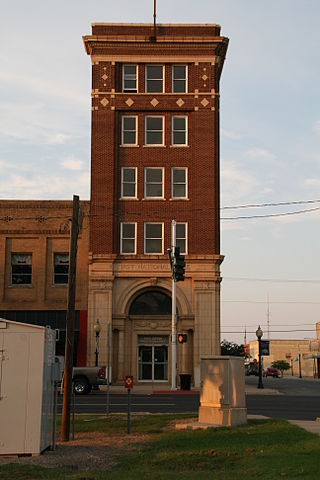
The First National Bank of Morrilton is a historic commercial building at Broadway and Moose Streets in Morrilton, Arkansas. It is a narrow five-story masonry building, occupying a prominent location at the city's main downtown intersection. It was built in 1925 to a design by architect Charles L. Thompson, and has Classical Revival and Bungalow/Craftsman features. The short Broadway Street facade features a recessed entrance with Classical features, while the upper floors are relatively unadorned red brick, with Craftsman motifs in tile around the top floor windows.
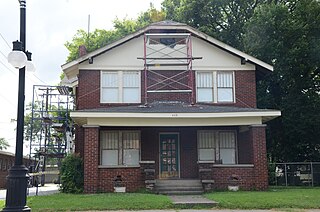
The First Presbyterian Church Manse is a historic church parsonage at 415 North Maple Street in North Little Rock, Arkansas. It is a two-story brick-faced structure, with a clipped-gable roof that has wide eaves with Craftsman-style exposed rafter ends and large brackets. A porch extends across the front facade, supported at the ends by brick piers, with a low brick balustrade on either side of the entry stairs. The house was built in 1927 as the official residence of the North Little Rock First Presbyterian Church's pastor. It was used to house ministers until the 1960s, and has since served a variety of functions, including youth center and law office.
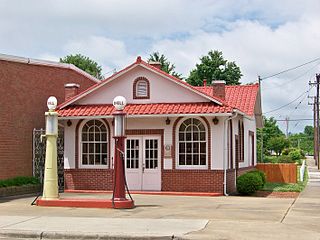
Beam's Shell Service Station and Office, also known as C. Grier Beam Truck Museum, is a historic service station located at 117 N. Mountain St. in Cherryville, Gaston County, North Carolina. It was built about 1930 by the Shell Oil Company, and is a one-story, rectangular Mission/spanish Revival style building. Associated with the service station are the original pump island and gasoline pumps.

The Murphy–Hill Historic District encompasses the oldest residential portion of the city of El Dorado, Arkansas. It is located just north of the central business district, bounded on the north by East 5th Street, on the west by North Jefferson and North Jackson Avenues, on the east by North Madison Avenue, and on the south by East Peach and East Oak Streets. Six of the 76 houses in the 40-acre (16 ha) district were built before 1900, including the John Newton House, one of the first buildings to be built in El Dorado. Of particular note from this early period is a highly elaborate Queen Anne Victorian at 326 Church Street.

The Rumph House is a historic house at 717 Washington Street in Camden, Arkansas. In 1874 a single-story Victorian house was built, in which Dr. Junius Bragg, a Confederate Army surgeon, lived for many years. This house was extensively remodeled in 1925, during Arkansas' oil boom, adding a second floor, and restyling the building in the then-popular Craftsman style. This renovation was undertaken by Garland S. Rumph, who was prominent in local politics. Its Craftsman features include wide eaves, stuccoed gable ends, and exposed false rafter beams.

The P. D. Burton House is a historic house at 305 Chestnut Street in Lewisville, Arkansas. The two-story wood-frame house was built in 1916 for Percy Duffield Burtun, and is an excellent local example of American Craftsman architecture. Its features include a jerkinhead roof with exposed rafter ends, and a porch supported by large brick piers and large brackets.
The Floyd Jackson House is a historic house on Jackson Street in Hardy, Arkansas. It is a single story fieldstone structure, built in 1929. Its architecturally distinctive features include a gable roof with extended eaves and exposed rafter tails, with colored wood shingles decorating the gable ends. The interior of the house retains original pine woodwork. It is an example of American craftsman/Bungalow style.
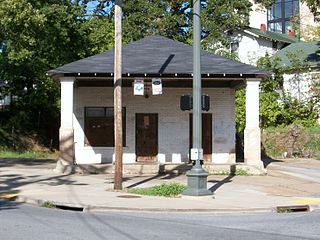
The Magnolia Company Filling Station is a historic automotive service station building at 492 West Lafayette Street in Fayetteville, Arkansas. It is a small single-story white hip-roofed brick building, with a portico, supported by brick piers, extending over the area where the fuel pumps were originally located. The building has a center entrance, with a single sash window to the left, and a large window to the right. Built in 1925, it is one of the region's oldest surviving gas stations, and, according to its National Register nomination in 1978 was the only one then known to have been built by the Magnolia Company and to still be surviving.

The Elm Street House is a historic house on Elm Street in Bald Knob, Arkansas. It is a single-story wood-frame structure, with an irregular plan that has intersecting gabled roof elements. It is finished in weatherboard and rests on a brick foundation. It has Craftsman features, including exposed rafter ends on the eaves and porch, and brick piers supporting the gabled front porch. Built about 1925, it is one of White County's best preserved examples of Craftsman architecture.

The Missouri-Pacific Depot, Ozark, now the Ozark Area Depot Museum, is a historic railroad station and museum at 1st and River Streets in Ozark, Arkansas. It is a roughly rectangular stone structure with a hip roof, standing between River Street and the railroad tracks. On its southern (rail-facing) side a telegrapher's booth projects. The roof has broad eaves extending around the building, supported by large Craftsman-style knee braces, and with exposed rafters visible. The station was built in 1910 by the Missouri-Pacific Railroad, and is notable for its association with the economically important railroad, and for its fine Craftsman architecture. It is now a local history museum.
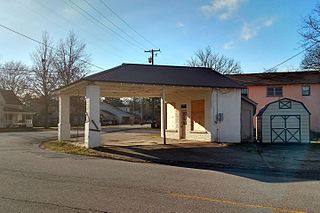
The Mount Ida Cities Service Filling Station is a historic automotive service station at 204 Whittington Street in Mount Ida, Arkansas. It is a small five-sided frame structure, finished in brick covered with stucco, with a hip roof that extends to form a canopy over the service area, with supporting brick piers at the far corners. Its front has fixed four-pane windows flanking a center entrance. Built in 1925 by Cities Service, it was used as a gas station until 1966, and has since housed a variety of small businesses. Its role as a gas station was briefly resurrected in the film White River Kid, which was shot here in 1998.
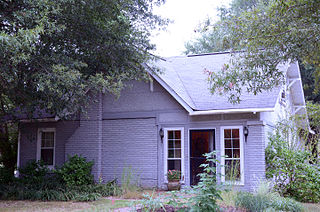
The Shue House is a historic house at 108 Holly Street in Beebe, Arkansas. It is a storey and a half wood-frame structure, finished in brick, with a cross-gable roof and a brick foundation. A gabled wall dormer features a half-timbered stucco exterior, and large knee brackets. The house, built in 1935 by the owner of a local oil company, is one of the city's best examples of late Craftsman architecture.

The Rogers House is a historic house at 400 West 18th Street in Little Rock, Arkansas. It is a large two story brick building, with an eclectic combination of Georgian Revival and American Craftsman features. It was designed by Arkansas architect Charles L. Thompson and completed in 1914. It has a green tile hip roof with extended eaves that show Craftsman style rafter ends, and is pierced by gabled dormers, which also have extended eaves, with large brackets for support. A half-round entry portico projects from the front, supported by monumental fluted Ionic columns. The house is one of Thompson's more imposing designs.

The Turner-Ledbetter House is a historic house at 1700 South Louisiana Street in Little Rock, Arkansas. It is a two-story wood-frame structure, its exterior mostly finished in brick, with a hip roof and a variety of dormers, projections, porches, and decorative elements typical of the Queen Anne period of architecture. Notable features include a three-story turret with flared conical roof, an entry porch with turned posts, bracketing, and a spindled balustrade, and windows with stone sills. The house was built in 1891-92 for Susan Turner, and was given additional Craftsman styling during renovations in the early decades of the 20th century.
The Meadow Spring Historic District encompasses a predominantly residential area north and west of the traditional center of Fayetteville, Arkansas. It covers an area of 22.5 acres (9.1 ha), and about 11 city blocks, roughly bounded by NW, School, Locust & Church Avenues. between W Dickson and W Mountain Streets. This area was developed beginning in 1870 and features mainly single-family residences on large level lots. It contains a variety of well preserved housing from the late 19th century into the mid-20th century, with both high-style and vernacular forms. Although there are a number of fine Queen Anne Victorians, the predominant styles are those of the early 20th century: Craftsman and a variety of Colonial, Tudor, and other revival styles.
The Magnolia Petroleum Company Filling Station is a historic automotive service station building at Larch and 1st Streets in Kingsland, Arkansas. It is a small single-story masonry building, built of red and buff brick and covered by a gabled roof. The front facade has a door on the left side and a plate glass window on the right. A concrete pad in front of the building originally supported the fuel pumps. The building was built about 1930, and is a good example of an early filling station with Tudor and Craftsman features, built to a Magnolia Company design which was used for at least one other filling station, in North Little Rock.

















